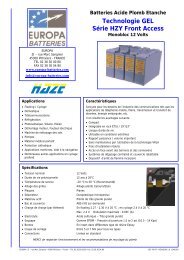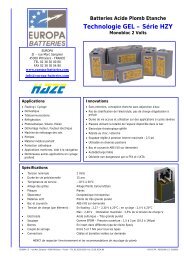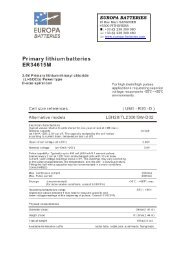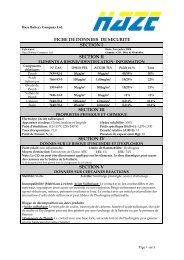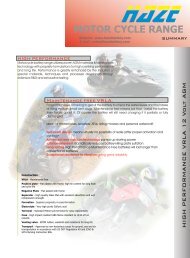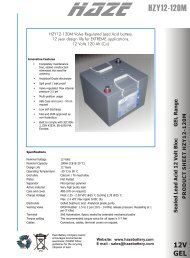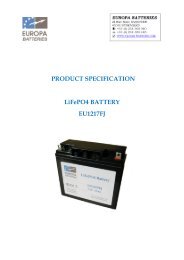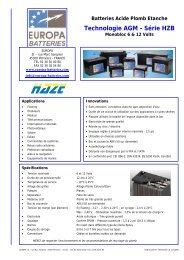PRODUCT SPECIFICATION LiFePO4 BATTERY ... - Europa Batteries
PRODUCT SPECIFICATION LiFePO4 BATTERY ... - Europa Batteries
PRODUCT SPECIFICATION LiFePO4 BATTERY ... - Europa Batteries
Create successful ePaper yourself
Turn your PDF publications into a flip-book with our unique Google optimized e-Paper software.
<strong>PRODUCT</strong> <strong>SPECIFICATION</strong><strong>LiFePO4</strong> <strong>BATTERY</strong>EU127.5FJ
1. SCOPEThe product specification describes the requirement of the <strong>LiFePO4</strong> Cell to be supplied to thecustomer by EUROPA <strong>Batteries</strong>. Should there be any additional information required by the customer,customer are advised to contact EUROPA <strong>Batteries</strong>.2. DESCRIPTION Rechargeable <strong>LiFePO4</strong> Battery3. Model EU127.5FJ4. GENERAL <strong>SPECIFICATION</strong>S4.1. Nominal Capacity 7.5Ah/min 7Ah (at 0.2C Discharge)4.2. Charging Voltage 14.6V±0.05V4.3. Average working Voltage 12.80V,@0.2C4.4. Standard Charge Method Constant Current and Constant Voltage (CC/CV)Current 0.2CVoltage 14.6VEnd Current 350mAEnd time 4h4.5. Maximum Charge Current 1CEnd time 2.5h4.6. Standard Discharge Constant Current (CC)Current 1CEnd Voltage 8.0V4.7. Maximum Discharge Current 1C ,3C peak4.8. Cycle Life Capacity≥80% Nominal Capacity after 1000 cycles4.9. Weight of Bare Cell Approx. 1.1Kg4.10. Operating Temperature Charge 0°C ~ 45 °CDischarge -20°C ~ 60°C4.11. Storage Temperature 1 month -20°C ~ 45 °C6 months -20°C ~ 35 °C5. OUTLINE DIMENSION (UNIT: mm)5.1. Dimension: max98mm (T) ×max65.3 mm (W) ×max151.4 mm (L), refer to the attached drawing 1.6. APPEARANCEThere shall be no such defect as deep scratch, flaw, crack, rust, leakage, which may adversely affectcommercial value of the cell.
7. TEST CONDITION AND DEFINITIONS7.1. Measuring Equipment1. VoltmeterInner impedance>1000Ω per volt.2. Ampere-meterTotal external resistance(ammeter and wire)
8.6. Cycle LifeCharge cells per 4.4 Rest 10 minutes. Discharge per 4.6. Rest 10 minutes before recharge. A cycle isdefined as one charge and one discharge. Discharge capacity shall be measured after 1000 cycles.Discharge capacity (1000th Cycle) ≥80% of Nominal Capacity8.7. Storage CharacteristicsAfter charge as per 4.4, store the testing cells at 20ºC±5ºC for 28 days. Then discharge at 0.2C to2.0V.Discharge capacity≥85% of Nominal Capacity8.8. Temperature CharacteristicsCells shall be charged per 4.4 and discharged per 4.6. except to be discharged at temperatures perTable 1. Cells , full charged, shall be stored for 3 hours at the test temperature prior to dischargingand then shall be discharged at the test temperature. The capacity of a cell at each temperature shallbe compared to the capacity achieved at 20 ºC and the percentage shall be calculated. Each cell shallmeet or exceed the requirements of Table 1.Table 1-10°C @0.5C 20°C@0.2C 60°C@ 1C≥40% Nominal Capacity 7.5Ah ≥90% Nominal Capacity8.9 Battery drawing:See attached file according to customers different request.Drawing 1
9. SAFETY9.1. External Short-circuiting TestCell, charged per 4.4, is to be short circuited by connecting the positive and negative terminals of thecell with copper wire having a maximum resistance≤50 mohms. Stop the test when the batterytemperature decays to about 10 ºC from the maximum.Criteria: No Explosion, No Fire9.2. Overcharge TestOvercharge test take constant current and constant Voltage. Charging at 3A firstly, the voltageincrease following charging time. When voltage reach 40V, cell charge with constant voltage, thecurrent decreases gradually. Stop the test when battery temperature decays to about 10ºC from themaximum or the current decays to less than 350mA.Criteria: No Explosion, No Fire9.3. Tack ThroughHitting the battery with a nail of diameter 2.5~5.0mm for 6h,end testCriteria: No Fire, No Explosion9.4. Heating TestCell, Charged per 4.4, is to be heated in a gravity convection or circulating air oven. Thetemperature of the oven is to be raised at a rate of (5±2)°C/min to a temperature of (130±2) °C andremain for 60 minutes at that temperature before the test is discontinued.Criteria: No Explosion, No Fire9.5. Pressing testFix the testing cells in the middle of bottom armor plate, pressing the cells with 13kN.Criteria: No Explosion, No Fire10.Danger and Warning and Cautions in handing the batteryDanger WarningDanger warning(it should be described in manual or instruction for users, indicated especially)Toprevent the possibility of the battery from leaking, heating, explosion,Please observe the following precautions:1. Do not disassemble or reconstruct battery.2. Do not short-circuit battery3. Do not use or leave battery nearby fire, stove or heated place(more than 80 ℃)4. Do not immerse the battery in water or sea water , or get it wet5. Do not charge battery nearby the fire or under the blazing sun6. Do use the specified charger and observe charging requirement7. Do not drive a nail into the battery. Strike it by hammer, or tread it8. Do not give battery impact or fling it9. Do not use the battery with conspicuous damage or deformation10. Do not make the direct soldering on battery11. Do not reverse charge or overdischarge the cell12. Do not reverse-charge or reverse-connect
13. Do not connect battery to the plug socket or car-cigarette-plug14. Do not use battery for unspecified equipment15. Do not touch a leaked battery directlyWarning1. Do not use Lithium ion battery in mixture2. Keep the battery away from babies3. Do not get into a microwave or a high pressure container4. Do not use a leaked battery nearby fire5. Do not use an abnormal batteryCaution1. Do not use or leave the battery under the blazing sun(or heated car by sunshine). The battery maysmoke, heat or flame. And also, it might cause the deterioration of battery’s characteristics or cycle life.2. Do not use nearby the place where generates static electricity (more than 64V).3. Do not charge the battery out of recommended temperature range of 0°C and 60°C.4. When the battery has rust, bad smell or something abnormal at first-time-using, do not use theequipment and go to bring the battery to the shop which it was bought.5. In case children use the battery, their parents teach how to use batteries according to the manualwith care.6. If the skin or cloth is smeared with liquid from the battery, wash with fresh water.



